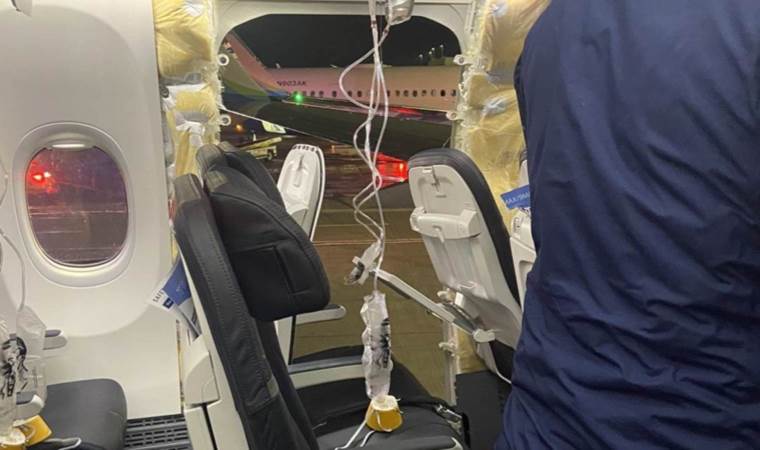Alaska Airlines suspends 737 MAX 9 after cabin issue
Alaska Airlines will temporarily ground its 65 Boeing 737 MAX 9 aircraft following a cabin panel blowout on a passenger-loaded jetliner, which necessitated an emergency landing on Friday, announced CEO Ben Minicucci.

The grounding is a precautionary measure, with the aircraft returning to service only after thorough maintenance and safety inspections, expected to be completed within the next few days.
Flight 1282, en route to Ontario, California, experienced the incident shortly after its 5:06 p.m. Pacific Time departure and safely returned to Portland, Oregon, at 5:26 p.m. The flight carried 171 passengers and six crew members, as confirmed by Alaska Airlines and Flightradar24 data. Photos and social media posts depicted a missing window and side wall section, with oxygen masks deployed. The panel in question is typically used for a rear mid-cabin exit door.
Alaska Airlines assured that such incidents are rare and their flight crew is well-trained to handle such emergencies safely. The National Transportation Safety Board and the Federal Aviation Administration have both launched investigations, with the latter confirming a reported pressurization issue by the crew.
The MAX 9 involved, delivered to Alaska Airlines in late October and certified in early November, features a rear cabin door behind the wings for dense seating configurations. However, Alaska Airlines' jets have these doors permanently deactivated.
The optional door, a feature from the earlier 737-900ER model, is often plugged in before delivery so operators do not need extra seats, reducing weight and offering cabin flexibility. Boeing and Alaska Airlines have not immediately responded to inquiries about the door.
Aviation safety expert Anthony Brickhouse from Embry-Riddle Aeronautical University emphasized the severity of rapid decompression events. He described the passengers' experience as likely loud, violent, and frightening. Brickhouse also highlighted the importance of seatbelts, commending the proper functioning of the oxygen mask system during the incident.
Boeing, recently advising inspections of all 737 MAX airplanes for potential loose bolts in the rudder control system, stated it is investigating the emergency landing. The FAA is monitoring these inspections and considering further actions if necessary.
The 737 MAX fleet faced a 20-month global grounding after two fatal crashes in 2018 and 2019, linked to cockpit software issues, resulting in 346 deaths. Boeing is currently awaiting certification for its smaller 737 MAX 7 and larger MAX 10 models. The FAA has been closely tracking all 737 MAX airplanes using satellite data since 2021.
Most Read News
-
 Earthquake of magnitude 6.2 shakes Istanbul, with no cas
Earthquake of magnitude 6.2 shakes Istanbul, with no cas
-
 Germany offers Syrians up to $4,555 to return home
Germany offers Syrians up to $4,555 to return home
-
 Despite stated ban, Spain continues to buy arms from Isr
Despite stated ban, Spain continues to buy arms from Isr
-
 China denies having talks with US on tariffs
China denies having talks with US on tariffs
-
 60 militants from paramilitary RSF killed in North Darfu
60 militants from paramilitary RSF killed in North Darfu
-
 Nearly half of Americans now live with dangerous air qua
Nearly half of Americans now live with dangerous air qua
-
 Zelenskyy partially cancels South Africa visit in wake o
Zelenskyy partially cancels South Africa visit in wake o
-
 Britain lifts sanctions against Syrian defense, interior
Britain lifts sanctions against Syrian defense, interior
-
 Pakistan says any Indian attempt to divert, stop flow of
Pakistan says any Indian attempt to divert, stop flow of
-
 Turkic world will continue to stand by Turkish Cypriots,
Turkic world will continue to stand by Turkish Cypriots,













